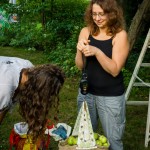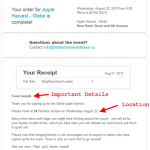Volunteering to Pick Fruit
Leave a CommentA Hidden Harvest Ottawa “Harvest Event” consists of a small group of volunteers picking fruit from one or two trees. All harvesting equipment is provided and the Lead Harvester will give you an run-through of how the harvest works at the beginning of each harvest. It usually takes about 2 hours to harvest one large tree.
If you would like to pick fruit with us, here’s an overview of the process:
Step 1: Sign up to VolunteerComplete our volunteer form and select “Harvester” as your preferred role. And, if you’re keen to lead harvests yourself, go ahead and also check off “Neighbourhood Leader” to receive more information! The volunteer form will ask you to select the areas of Ottawa you would prefer to harvest fruit in. Select a few wards where you live, work, and play, and then you will find out about any harvest events scheduled in those areas – often planned a week in advance. |
 |
Step 4: Attend the HarvestLet the fun begin! You must show up on time if you wish to receive a share of the harvest. The event will begin with instructions on safety, proper harvesting techniques, and a tidy of the area before the picking gets underway. More information on Harvest Events here. |
 |
Frequently Asked Questions:
Can I bring my child / friend / partner?
We are seeking to find a balance between encouraging community and enabling everyone to have a chance to attend a harvest event. Presently, up to two spots in a harvest event can be reserved at once – a parent may sign up their child, or one friend can invite another friend – just ensure they have also signed up as a volunteer with us!
Note: Children 15 and under are welcome, but must be accompanied by a parent or guardian. Teens aged 15 to 18 must bring with them a copy of the waiver signed by a parent.
Why are harvest events always full? Why is there always a waiting list?
If you are having trouble getting into a harvest event for your area, it is likely because need more Neighbourhood Leaders to lead harvests, or because we need to find more trees to harvest in your neighbourhood. You can help by training to become a Neighbourhood Leader yourself, or by encouraging your friends, family, neighbours, and colleagues to become Neighbourhood Leaders! You can also help by downloading and sharing our poster & leaflet with homeowners in your community who might have trees to harvest.
I signed up to volunteer, why haven’t I heard from anyone?
Not to worry, you’ve successfully signed up if you’ve seen the “Volunteer Sign-Up Confirmation” page. We do our best to respond to questions, but sometimes we are not able to respond individually to every one of our amazing volunteers as we are all volunteers ourselves!





